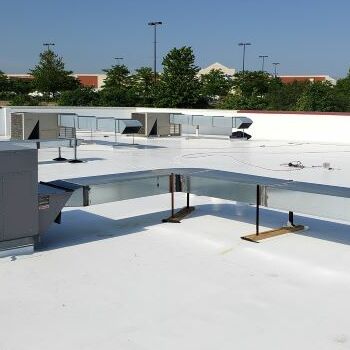
A common roof style for large commercial structures is flat roofing, or what appears to be flat. Technically, the roof has some slope to it so that the water can drain instead of pooling up on the roof. However, if the drains are clogged, the water will pool, causing damage to the flat roof. Repairing this damage sooner rather than later is important for the protection of the structure.
How does a flat roof get damaged?
There are several benefits of flat roofing, starting with the cost-effective installation. They are easy to access and are energy efficient. An exception to flat roofing is a perfect place for several types of building components like communication equipment and the HVAC unit. equipment.
But a flat roof can have issues and problems too. Ten things that can create vulnerability and need flat roof repairs are:
1. Exposure: Every roof is exposed to the elements, and a flat roof is no exception. The UV rays and other weather elements, like chemical exposure and pollution, can take a toll on a flat roof over time. Routine inspections are needed to stay on top of flat roof repair needs.
2. Leaking: Flat roofs are known for leaking, but with proper installation, and maintenance, which includes cleaning the roof surface and drains, and routine inspections, leaking can prevent the need for emergency flat roof repairs.
3. Ponding: Innately, without clear and properly placed drainage, water will pool up on flat roofs. That pooling water will sit on the roof and begin seeping into the membrane. Soon, leaking begins and if not discovered and flat roof repairs are done, it leads to structural damage.
4. Punctures, Splits, and Tears: A flat roof is prone to punctures and tearing caused by foot traffic and storm damage. With a professional inspection after a weather event, flat roof repairs can be addressed and prevent any further damage. Days, weeks, and months of weather exposure can cause membranes to split, and if flat roof repairs aren’t done to repair those splits, a leaking roof will soon follow.
5. Building Movement: Buildings will move with the temperatures, contracting and expanding. These can cause a roofing membrane to crack, tear, or split. This also affects the energy efficiency of the interior, causing energy bills to increase. Routine inspections are important to address small issues before they become extensive problems that require expensive flat roof repairs.
6. Debris Collected: It is normal for debris to collect on a flat roof, typically dirt, dust, leaves, and tree limbs. Routine cleaning should be performed along with inspections. Keeping the roof clean will minimize damages that require flat roof repairs.
7. Growths: Routine cleaning of a flat roof will minimize any growth forming from the debris and any stagnant ponding water, which can damage a roofing membrane, leading to expensive and multiple flat roof repairs. A dirty roof also dims the reflective ability of a flat roof, which can cause energy bills to increase.
8. Blistered Surface: A blistered roof surface and defects like alligatoring are common occurrences for flat roofing and can be an indication the roof may need to be replaced. A professional roofing contractor can inspect the roof and advise if flat roof repair or replacement is needed.
9. Shrinking Membrane: Flat roofing of a synthetic rubber membrane will experience shrinkage. This can pull the seams apart, exposing part of the roof which can lead to leaking. Prompt flat roof repairs are needed to prevent this from happening.
10. Maintenance Neglected: This is the number one cause of needing flat roof repairs. Keep the cleaning, maintenance, and inspection schedule will minimize, and even prevent needing frequent flat roof repairs.
How often should flat roofs be cleaned and inspected?
The recommended maintenance schedule is twice a year and after any significant weather event. This should include cleaning the roof surface, the drains, and around roof protrusions. If the roofing system has gutters, those should be cleaned at the same time.
During the cleaning, inspecting the roof at the same time should be standard procedure. Once a year, schedule an appointment with a professional roofing contractor for an inspection. If a severe, significant weather event comes through, having the roof professionally inspected afterward is recommended. This allows you to stay on top of any issues for flat roof repairs.
In Closing
The average lifespan of a flat roof depends on the membrane that is installed, and the follow-up maintenance. Most flat roofs that are properly installed with top-quality roofing material and adhering to a maintenance schedule can last up to 25 years. Some examples of lifespans include:
- BUR roofing, a combination of gravel and hot tar typical lifespan is between 15 and 20 years.
- Single-ply roofing has a lifespan expectancy of 30 years.
- EPDM rubber membrane roofing can last up to 30 years.

